Do you want to understand HVAC diagrams better? This guide will help you. It’s made to help you with types of HVAC system plans and designs.
You’ll see various diagrams like schematic, plan, elevation, and isometric ones. They show HVAC parts and how they work together. Knowing these diagrams well is key for HVAC pros. It helps make sure systems work great and follow the rules.
Key Takeaways
- Understanding HVAC diagrams enhances installation accuracy and system efficiency.
- Different types of HVAC diagrams serve specific purposes in illustrating system design.
- Professionals use these diagrams for optimal functionality and to meet building codes.
- Knowledge of various HVAC components and their placement is crucial.
- Accurate HVAC diagrams support energy-efficient and safe building environments.
Introduction to HVAC Systems
Understanding an HVAC system is key to having good indoor air. It controls the temperature and ensures you’re comfortable. HVAC includes a lot of equipment, from big industrial systems to small home ones.
HVAC systems use thermodynamics, heat transfer, and fluid mechanics. A diagram of the system shows how parts work together for a stable indoor climate. Inside and outside parts join forces to adjust the temperature and air quality.
In both businesses and homes, the layout of HVAC gear is carefully planned. It needs to use space well, work efficiently, and be easy to take care of. It focuses on where to put ducts, vents, and controls for the best results.
Thinking ahead about what questions people may have can help learn more. Questions like:
- What components make up an HVAC system?
- How does an HVAC control diagram assist in system design and troubleshooting?
- What factors should be considered when planning an HVAC equipment layout?
- How do indoor and outdoor components work together in an HVAC system?
- What are the common principles behind HVAC system operations?
Importance of HVAC Diagrams
In the world of HVAC systems, diagrams play a huge part. They make sure every part is put in the right place. This is key for working correctly and safely, and for saving energy. These drawings show the best way to lay out the system.
Ensuring Accurate Installations
Professionals find an HVAC ductwork guide very helpful. It tells them exactly where each part should go. This makes the setup smooth and prevents problems later. A well-installed system works its best.
Facilitating Maintenance and Troubleshooting
For fixing and keeping systems working, an HVAC wiring diagram is a lifesaver. It clearly shows how the wiring is set up. This helps technicians spot and fix problems fast. It also makes care easier, helping the system last longer and work better.
If things need to change or grow, these diagrams are a must. They make sure new parts fit right and keep everything running smoothly.
Key Components of an HVAC System
An HVAC system links indoor and outdoor parts. They work together for perfect climate control inside. Learning about these components helps in understanding HVAC ductwork and wiring diagrams.
Indoor Components
Indoor parts of an HVAC keep the temperature and air quality right indoors. They include:
- Evaporator Coils: These coils pull heat from the air. They help cool the inside effectively.
- Air Handling Units (AHU): AHUs spread conditioned air across the building. They follow HVAC ductwork guides.
- Furnaces: Furnaces use fuel to make heat. The air handler then spreads this heat around.
Outdoor Components
Outdoor parts work with indoor ones to keep the inside temperature steady. Important outdoor units are:
- Compressors: Compressors in the outdoor unit move refrigerant. They change it from low-pressure to high-pressure gas.
- Condenser Coils: These coils remove heat from the air inside. They blow it outside to keep things cool.
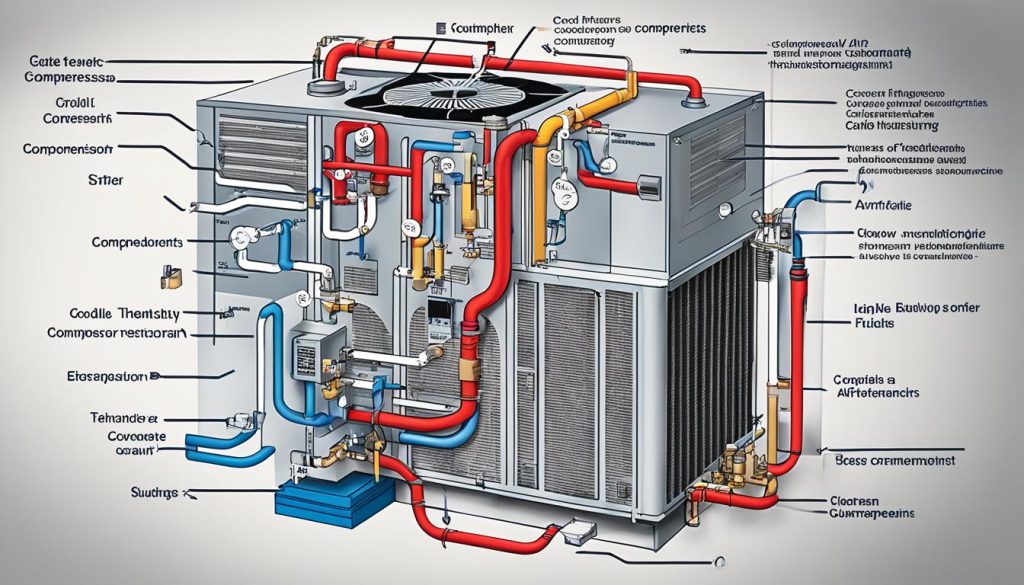
Full HVAC diagrams show how all parts fit together. They’re key for proper setup and operation. They make installing and keeping the system running well much easier. This includes knowing how to read HVAC wiring diagrams.
Understanding components and how they work lets you know a lot about an HVAC system. The right diagrams, like those for ductwork and components, are crucial. They make sure everything goes smoothly when setting up and caring for the system.
Reading HVAC Diagrams
Learning to read an HVAC diagram is about knowing what the symbols mean. This applies to both HVAC schematic design and HVAC control diagram. It’s crucial to be able to understand these diagrams well.
To get better, you should know what system parts the symbols represent. Think of vents, fans, ducts, and thermostats. Knowing how these parts fit together is key. It helps a lot with setting up and keeping the HVAC system working well. This also helps with saving energy.
Being good at reading HVAC diagrams means getting to know a few things well:
- Symbols: Get to know the symbols for different parts.
- Legends: Know what the legend says about each symbol.
- Scales: Learning about scales helps you measure parts right.
Focusing on these areas can make you better at understanding both HVAC schematic designs and control diagrams.
Types of HVAC Diagrams
In the HVAC world, knowing various HVAC diagrams is key. They help in making and keeping systems running well.
Schematic Drawings
Schematic drawings show how an HVAC system looks and air moves in it. They are great for seeing how parts in the system work together.
Plan Drawings
Plan drawings give a view from above. They show where things go and space limits, making the system design clear and working well.
Elevation Drawings
Elevation drawings show things from the side. They show how parts are placed vertically. This makes putting in and taking care of parts easier to understand.
Isometric Drawings
Isometric drawings show the HVAC system in 3D. They help understand how everything connects. These are good for planning and seeing complex systems clearly.
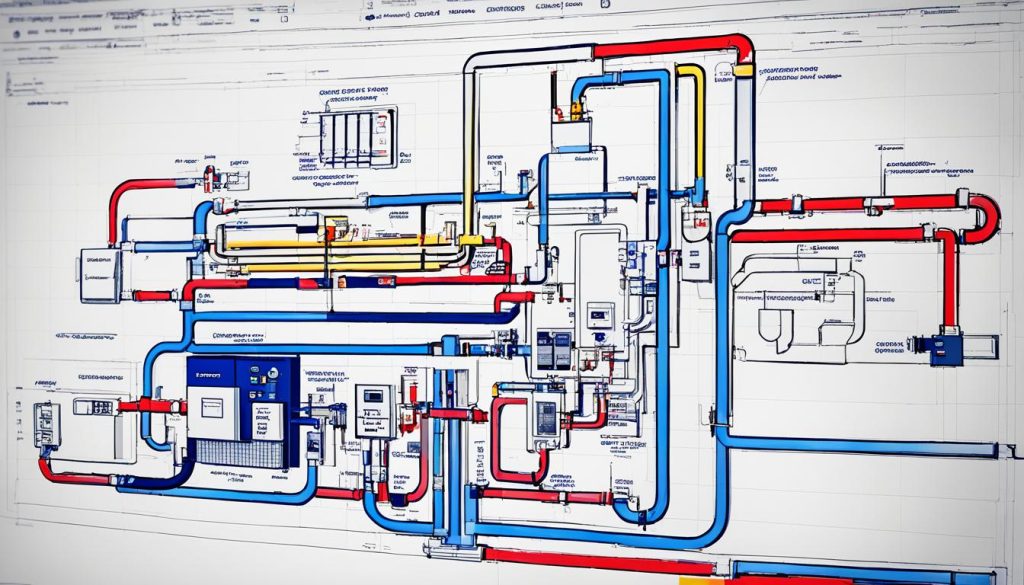
HVAC Ductwork Guide
Understanding HVAC ductwork is key to getting air right in your building. With a good guide, you learn about duct paths, sizes, and how to install them. The right ductwork keeps air clean and the temperature just right.
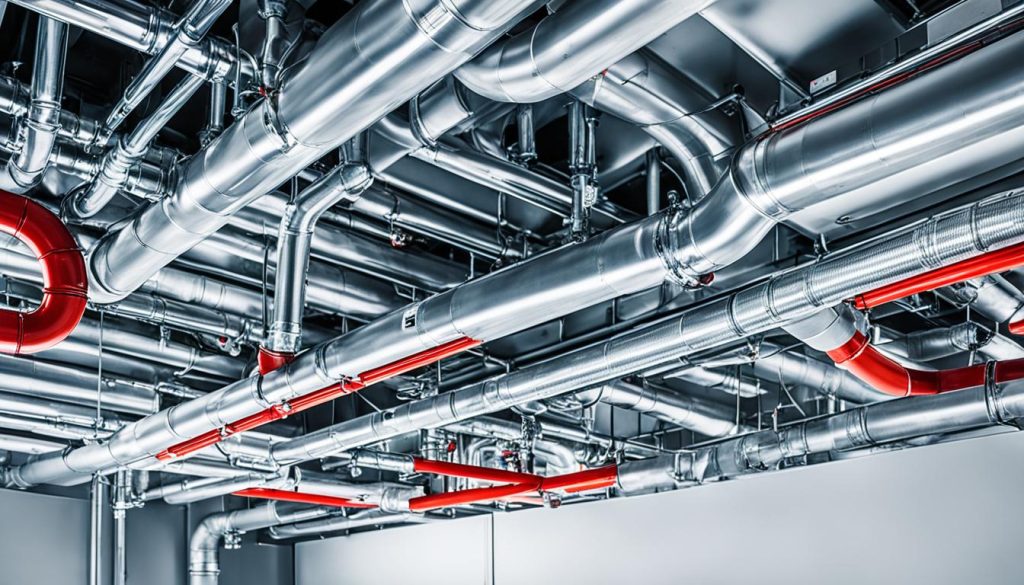
It’s important to map out HVAC zones to heat or cool each area properly. Ducts must be laid out and wrapped well to save energy and keep everywhere comfy.
Also, connecting the HVAC’s wiring plan helps with upkeep. Good wiring links things like thermostats correctly, making the system work better and easier to fix.
Here’s a chart to compare HVAC ductwork design elements:
| Consideration | Description |
|---|---|
| Duct Sizing | Proper sizing means air moves well and the system works right. |
| Insulation Types | Insulation choices keep heat in and save energy. |
| Routing & Placement | The right path and place helps save power and keeps you comfy. |
| Compliance with Codes | Meeting building rules keeps things safe and makes your HVAC work well. |
A complete HVAC ductwork guide covers these points. It offers insights to boost your system’s efficiency. Good duct design and location cuts costs and makes your space more pleasant. Stick to these tips for a better, stable HVAC system that fits your needs.
HVAC Wiring Diagrams
Understanding an HVAC wiring diagram is key for the right HVAC setup. They show how parts connect to work properly. These diagrams are used in homes and businesses to hook up things like the thermostat and the evaporator.
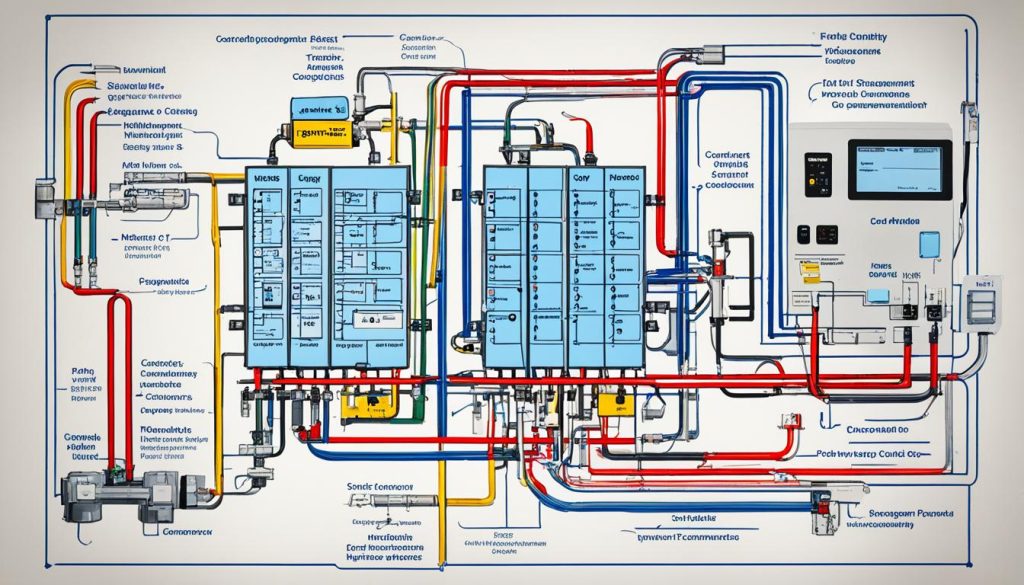
In an HVAC control diagram, you see how the thermostat links to the other big parts. The thermostat controls the system. It talks to the compressor and the condenser to keep the temperature right. The wiring diagram shows all these links to keep everything running smoothly.
If there’s an electrical problem, the HVAC wiring diagram is a big help. Technicians use it to find and fix faults. It makes repairs fast, so the building stays comfy for everyone inside.
The HVAC equipment layout map shows where all the parts go and how they connect. This helps with setup by giving clear steps on what goes where. It makes everything a lot easier.
So, knowing how to read HVAC diagrams is really useful. It makes setting up and fixing HVAC systems go smoothly. This keeps the system running well for a long time.
Tips for Creating Efficient HVAC Diagrams
It’s key to make efficient HVAC diagrams. They help ensure system accuracy and cut down on mistakes. By using digital tools and working with other trades, you make your HVAC designs better.
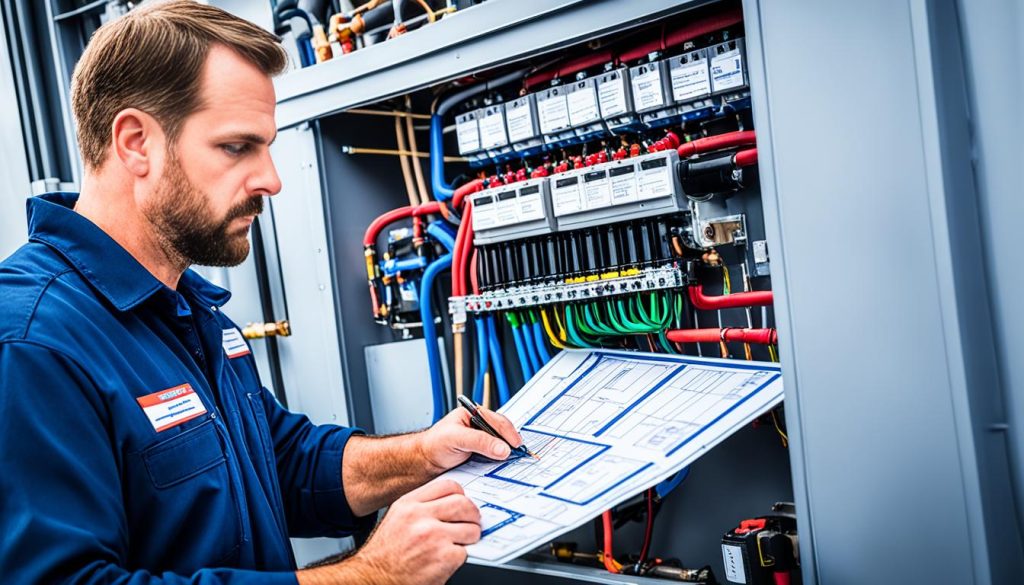
Using Digital Tools
Digital tools boost the quality of your HVAC diagrams a lot. They include things like Building Information Modeling (BIM), the Internet of Things (IoT), and AI for maintenance. These tools make your HVAC plans easy to see, adjust in real-time, and update without hassle.
Ensuring Accuracy
Getting your HVAC control diagrams right is super important. Use exact measures, put symbols in correctly, and follow the rules. Always check your data, test your designs, and go over everything with the team regularly. This means less mistakes and more reliable diagrams. With spot-on plans, your installs and maintenance will be smooth.
Coordination Among Trades
Getting different trades to work together well is a must for great HVAC plans. Have meetings, use the same digital tools, and plan together. This makes sure every part fits smoothly with the building. It stops problems, cuts redo work, and makes sure your HVAC diagrams are solid and cover everything.
Focus on these tips to better your HVAC diagrams. This way, your system will run and be maintained at its best.
Conclusion
The HVAC Diagram Guide gives you a detailed look at HVAC system design and how it works. It helps experts create accurate diagrams for better installations and maintenance. This leads to systems that work well.
These diagrams are key to making buildings safer, more comfortable, and using less energy. They show where each system and its parts should go. This makes the job easier for engineers, architects, and technicians. Also, using them correctly helps follow rules and makes HVAC systems last longer.
In the end, a well-made HVAC diagram does more than show plans. It helps turn ideas into actions. With this guide, you can now understand HVAC setups better. You’ll feel more confident in creating systems that make buildings work smarter and use resources wisely.





0 Comments